I think if the real Suzy Homemaker had to can 100 pints of meat, or anything, she would be haggard and worn. However, modern day technology and science makes the tasks of our ancestors a proverbial cake walk. I often tell my students that I truly am the laziest preparedness person they will ever meet. If there is an easy way to do something, I find it. I work full-time nearly 6 days a week and have to manage my physical and emotional energy wisely. I assure you that if canning meat was a real torture, I certainly wouldn’t be doing it. So today, I’m going to hold your hand and walk you through this task step by step.
Why? Because it’s too easy and too cheap for you NOT to be doing it. I find that it’s about a quarter of the price of canned meats—even those at Costco. Not only that, but there is a distinct difference in taste between the commercially canned meat and that which you can yourself. Seriously; I’ve NEVER tasted store-bought canned chicken that’s as moist and tender as the meat I can myself. It’s truly a delight!
Why I love to can my own meat
Oh yeah, and another reason why I love canning meat is because my freezer is always FULL but I hate to miss out on buying loads of meat when it hits a rock bottom price just because I'm out of room. I mean really, I’m going to wish I had it later, right? So, when I can the meat instead of trying to find room in my freezer, I’m only limited by the number of jars I have on hand. Considering I can get those in abundance at Goodwill or at Salvation Army type stores; that really isn’t an insurmountable problem.
Just to answer a few anticipated questions initially; no, you do not have to add water to your canned meat. The meat, just like our own bodies already has sufficient moisture in it. However, I do so because I look at it as “free” broth that gets a deeper flavor over the years; so why not? Also, yes, you are able to can any kind of meat. I even can bacon! You can even can shrimp, halibut, ground beef, turkey, and steak.
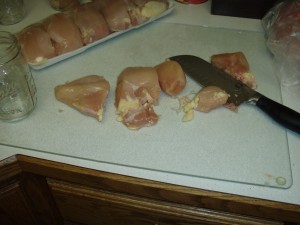 Try to keep the meat in as big of a piece as possible so you don't have limited uses for it once it's opened.
Try to keep the meat in as big of a piece as possible so you don't have limited uses for it once it's opened.All Rights Reserved 2012 Preparedness Pro/Kellene
I try to keep the meat in as big of a piece as I can so that I don’t get pigeon-holed into a specific use for the meat. For example, when I bottle pork sirloin, I keep it as large a piece as possible so that I can use it as a small pork roast with potatoes and carrots or I can cut it up for Pork Guisada. This is also why I do not pre-season my meat with ANY seasoning, though a pinch of salt is fine, it's not necessary.
Here’s what you’ll need to can your meat:
- A pressure canner. (I use an All-American brand. They are currently about $200 bucks on Amazon.com)
- Clean Mason jars with NEW lids (it doesn’t matter which brand you use, Kerr, or Ball. I don’t think I’ve even seen the actual brand “Mason” is quite some time). I prefer to use the large mouth, pint size jars since 1 pint usually holds a pound of meat and that’s what most recipes call for.
- A sharp meat knife
- Paper towels
- White Vinegar (dampen your paper towel with it when you clean the rims of the jars.
- A butter knife
- Meat (with or without the bone in it. Your meat does NOT have to be cooked unless it’s ground meat. In which case you should brown it and then pack it.) When I’m bottling fresh fish, I take out the major bones as much as possible, but I don’t bother with the tiny ones. They tend to disintegrate in the jar through the pressure canning process.
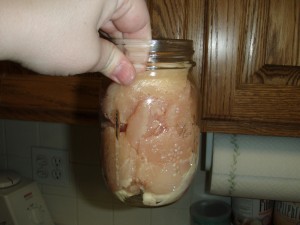 Make sure the meat and fluid only come to the bottom rim.
Make sure the meat and fluid only come to the bottom rim.All Rights Reserved 2012 Preparedness Pro/Kellene
Open the jars and lay the lids off to the side while you work with your meat. Cut your meat to the desired size and place it in the jars. I prefer to only handle the inside of the jars once I’ve started packing them so that I don't get any fat or oil on the rims as that can compromise the seal. Fill the jars up only to the bottom of the screw rim area on the jar—no further. This is known as "head space/head room."
Once you’ve filled all of the jars with meat, pour in enough warm water to fill in the gaps of the meat packing. Remember, you don’t want to fill the jars any higher than the lowest point of the screw portion of the jar. (If the jar is not a wide mouth jar, then I actually stop right at the bend on the top of the jar, which is just below where the screw joint begins.)
Once you’re done filling in all of you jars with water, then go back with a butter knife and slide it down the inside of the jar. Doing so will allow more of the water to fill in the air gaps of the meat in the jar. I press the meat in a bit towards the center of the jar while I’m doing this to encourage better filling. Inevitably when you’re finished with this process, your jars will need a tad bit more water. Fill accordingly.
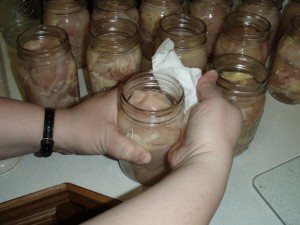 Use a paper towel and white vinegar to wipe off any excess fluid
Use a paper towel and white vinegar to wipe off any excess fluidAll Rights Reserved 2012 Preparedness Pro/Kellene
Once you’re finished filling the jars, take a clean paper towel, moisten it with vinegar, and then wipe the outside screw rim of the jar as well as the top rim. You want to make sure that there are no meat pieces, oils, debris, or fat on that section as it will compromise the jar sealing properly. Place the lid firmly on each jar and screw on "finger tip tight." You don't want to man-handle these tightly closed at this point.
Place one of the racks that should be a part of your pressure canner set at the bottom of your pan. This is a must as the jars should not come in contact with the bottom of the pot. Fill your pressure canner 2 to 3 inches with water. (see your instruction manual for your particular canner) (Using warm or hot water will result in it taking less time for your canner to come up to full pressure. ) Add 1/4 cup of white vinegar. This will prevent the calcium/hard water stains on the jars and in your canner. Place the filled jars on the bottom rack inside your pressure canner, giving each jar just a bit of wiggle room. (NEVER put your jars directly on the bottom of the canner; always use the rack.) Then place your second rack on top of that layer of jars and top it with filled jars as well.
Place the lid on the canner according to manufacturer’s directions WITHOUT the pressure weight. Turn the burner on High. Allow steam to exit pressure valve for 5 minutes, then place the pressure weight on your pan, according to manufacturer’s directions and in consideration of your altitude.
Bring your pressure canner up to the appropriate pressure measurement (based on the kind of meat you’re cooking and your altitude) and then adjust/lower the heat to hold that pressure without needing to extract much heat or steam from the pressure weight valve. (This should take anywhere from 60-90 minutes.).
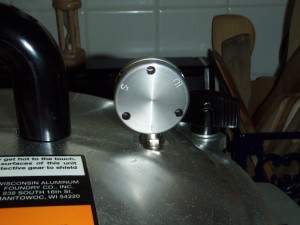 Make sure you adjust your pressure weight to your altitude requirements. All Rights Reserved 2012 Preparedness Pro/Kellene
Make sure you adjust your pressure weight to your altitude requirements. All Rights Reserved 2012 Preparedness Pro/Kellene
Upon finishing the pressure canning, remove the pressure canner lid according to manufacturer’s instructions.
Wipe off all of the jars with a clean, dry cloth and tighten the lids (as they will loosen in their grip during the canning process). Label the contents of the jar simply by writing on the flat part of the lid. I label it with the kind of meat in the jar as well as the month and day it was canned i.e. “Chx Brst 1/10” (translation: chicken breast, January 2010—thanks to all of my years waiting tables) Store in a cool, dry, place. Your canned meat will now store easily and safely for 3 to 5 years and you will love the taste!
Category:
© 2019 Of COURSE this post is Copyright Protected by Preparedness Pro. All Rights Reserved. NO portion of this article may be reposted, printed, copied, disbursed, etc. without first receiving written permission by the author. This content may be printed for personal use only. (Then again, laws are only as good as the people who keep them.) Preparedness Pro will pursue all violations of these rights just as vigorously as she does any of her other freedoms, liberties, and protections.
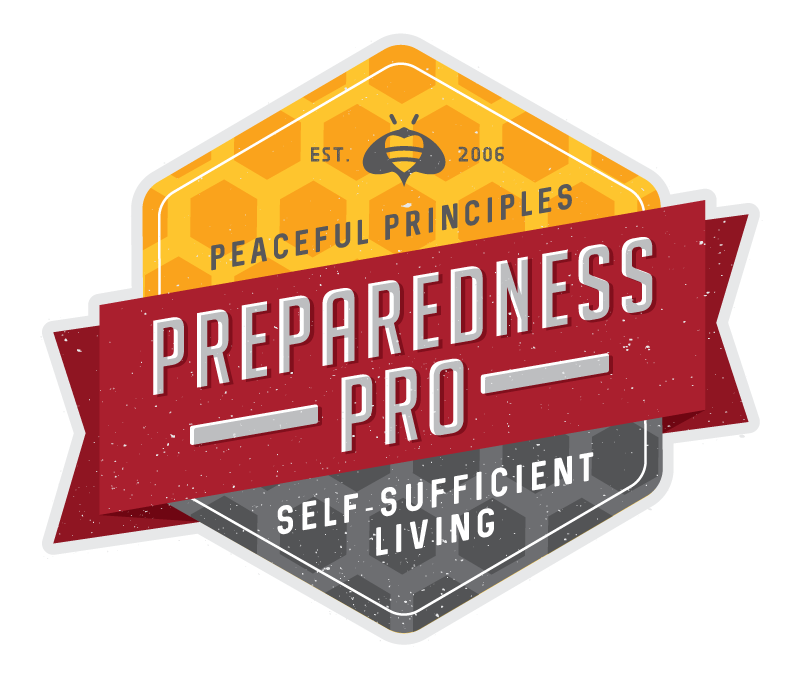
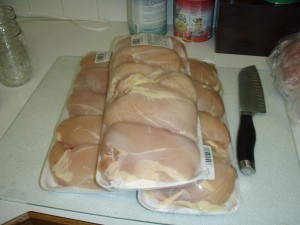
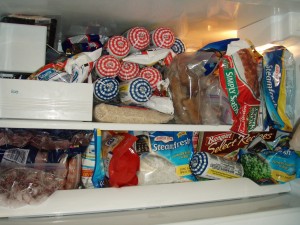
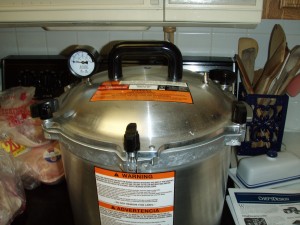
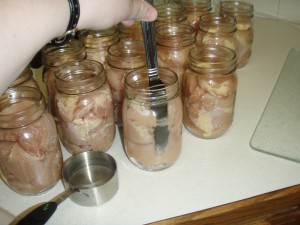
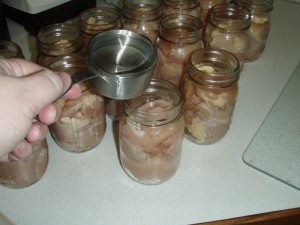
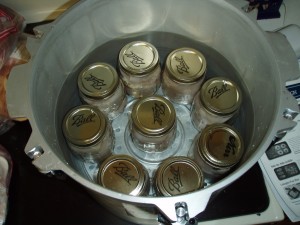
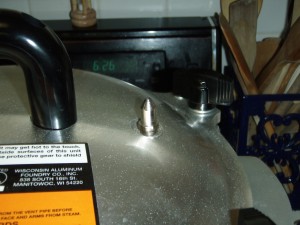
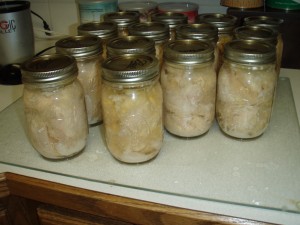

Comments
Thanks, Kellene. That is So Exciting! I appreciate that you're willing to take flack from some to help Many! Blessings!
Thank you so very much for sharing this with us Kellene. Do you can all meats the same way?
p.s. I've always wanted a daughter. Can I adopt you? lol
Everything except for processed meats (which I only do in chunks) and ground beef/sausage/turkey/chicken all get cooked before they get put into the can as there's just way too much surface space potential for bacteria growth.
Adopt me? Well, you should know I'm a Buckeye Fan, feisty, and I"m not voting for Romney or Obama. My dad hung up on me when he learned of the last issue. :-) I may just be too much for anyone to handle--except my Prince Charming. *hugs*
Anything larger than a quart size is NOT suitable or recommended for canning--neither water bath nor pressure canning. However I do use the half-gallon size all the time for my dry canning in which I use the FoodSaver to extract all of the oxygen from the jar. (See "FoodSaver Saves the Day" article on here or go to our YouTube page--youtube.com/preparednesspro and see the video I have posted for using the FoodSaver.)
I think the larger jars are actually meant for pickling.
Not from what I've learned; They've been used primarily for "Open-kettle" canning which is not considered true canning.
I've never heard of open kettle canning but I know my grandmother used gallon jars for fermenting pickles and also cabbage into sauerkraut.
in years past "open kettle" was consideres canning, at least for the use of glass jars, technology has caught up and science proved it was not safe so it was discarded
half-gallon and gallon jars were first used many years ago when families were much larger and you needed more food to make a meal. you had to add processing time to what was allowed for a quart but I don't know how much. I have a very old Kerr canning book that I can look at and see if there is a time given for halves don't know about gallons. As for open kettle canning it is where foods especially fruits, peaches, apples maybe pears, were cooked in a pan on the stove top and the boiling cooked fruits were put directly in the clean jars and the tops and rings screwed down and allowed to cool. the cooling product caused a vacume and the jar would seal. it is not recommended today. Tomatoes were canned in this manner but they didnot keep well and were not safe for use. I have canned some open kettle long ago but now I have gone to water bath for fruits. will cook until just tender and then put in the jars and into the water bath and let boil 25 min once it has reached a rolling boil. 20. min is considered steirile and this is giving a little time in case it wasn't boiling good when you started timing. Have had no problems by doing this and few jars that didn't seal. Guess I'm getting old because I remember some of the older things or maybe it was the fact my mama was an older woman and she knew them and passed them on to me.
I do grape juice this way.
I do grape juice this way. Hot jars, boiling juice right out of the steam juicer, wipe the rims, and put the lids on. They seal, and the sugar content of grape juice is so high that it's pretty safe. I think I've had one or two over the years not seal completely, but when I go to open it it's pretty obvious that I don't want to be drinking it.
I never realized canning meat was so easy. My eyes have been opened. I realize there may come a day when grocery store shelves could be empty and I how important it is going to be to enhance my food resources other than emergency food buckets. I'm thankful that there are those so willing to share.
You have answered so many questions about food processing for me in this section! I feel confident enough from your knowledge and experience to go beyond what I am presently doing with my meat canning. I do appreciate your telling about the pressure canner that you use. I am looking for one that will can the size above quart jars. I am trying to formulate an Italian marinara sauce and some Italian sausage for canning. Any help would be appreciated.
I've not done that recipe specifically but here's what I know will result if you do...you'll love it because the pork will be marinating in those fabulous flavors for the years that you keep it on the shelf. Heaven!!! I don't believe you'll be making a mess AT ALL! Just let me know what time to show up for dinner. :-)
Sounds like a GREAT idea. I'm tickled that you "get it" in terms of protecting your investment of food!
Sure you can do that. I suspect though that they are already cooked and just need to be warmed up, but that's how folks typically can meatballs--cooking first so that they hold their shape and then can them.
I can my chicken in the largest possible pieces that I can so that I don't get pigeon-holed into just one kind of chicken. When I get my Zaycon order of chicken breast, I stuff the entire half of a breast in the jar and then a second piece typically, for this very reason. You can try that or you could partially cook the chicken, much like you would the meatballs from scratch, and then can them.
Finger tight is the standard way to put the lids on. I must have written a rookie type of line. I'll fix that. As for why your jars aren't sealing, it could be something as simple as particles or fat along the ridge of jar. Also, be sure you're not covering the jars with water, rather you're just putting two to three inches of water in the canner. I've got to tell you, I've never heard of someone consistently having problems with a couple of jars not sealing; that's an odd one indeed. However, it's great that you check and double check your seals before putting them away--for situations just like this. Way to go.
I almost always get one jar that doesn't seal.
So glad that doesn't happen to me! That would drive me bonkers.
good to know , thanks for the tips
Two questions: Our local grocery stores often have frozen meatballs as a BOGO special. Is it possible to let them thaw, then can them? Or might they turn to mush? Second, I've canned chicken and its great for making shredded chicken BBQ sandwiches, but I don't always want my meat to be that soft. I'd like more "solid" pieces for various recipes. Is this possible? Thanks!
All most every time I can, a couple of jars don't seal. I thought you said to lightly tighten the lids but in this article it says to screw on tightly. Do you think this is my mistake?
Kellene, we love pork loin roasts that have been marinated with garlic and teriyaki sauce. Have you ever pressure canned this and how was it? I hate to make a mess of such a nice piece of pork. Thanks for any advice!
Darlene
That wouldn't be accurate information, Karen. You don't have to boil the canned chicken or tuna that you can buy at the stores. You'll lose all of the tenderness and flavor if you do that too. You can eat it right out of the jar just as the other reader mentioned. The same is true for veggies. Someone's just being a bit paranoid by suggesting the need to cook them after being canned.
Yes, it will look "raw" as you put it, in other words, void of the browning and such because you haven't cooked it in any way to be "brown" up to that point.
I don't preserve the ham, it's smoked and thus doesn't have a great texture after being smoked and then pressure canned. I just freeze it and eat it up soon cause it's so dang good.
Karen, We eat it right out of the jar on crackers and make chicken salad sandwiches. No heating or boiling needed. After 7 years of this I am still upright.
I don't worry about the meat shrinking as it's cooked. That's just how meat is; it's what it's supposed to do. Just don't expect Martha Stewart perfect. All is well. Enjoy!!!
Hi, nice reading here. I havnt canned meat since I was about 10. Then I helped my mom put up a whole beef. She is long gone so I cant ask her. My wife and I canned chicken breasts yesterday they came out perfect. We bought several round roasts cut them in chunks added them to quart jars leaving a inch head space (raw pack) with a tsp of salt oh and ran a thin plastic around the meat to went air, processed @ 15 pounds for 90 minutes. The finished product shows meat a little over half full on jars with liquid about 3/4. Did I need to pack tighter?
thanks for the help
You are amazing! Never knew anything about "Being Prepared" until I watched you on NatGeo!! I also had never canned anything before!
Buuuutttttt now you have done it!! I first canned bacon wrapped in the parchment paper. Then I canned chicken breast. Then canned ground beef. ALL from Zaycon of course! Their meat is the best I have ever seen in my lifetime!!! Now I have canned beef roast, pork butt and venison we had in the freezer. We precooked only the ground beef. We process all our meat in pints at 10 lbs. pressure for 75 minutes. MY TIP for the day---anytime there is space left in our canner (not enough product to fill a jar), we always process BUTTER in jars as our fillers!!! Thanks Kellene for being so inspirational!
The answer to your question is located in the most recent article that is posted on the home page. :-)
You're going to get a texture that you may not be a fan of. I'd suggest that you try canning just one pint/quart of them first. You'll can according to hot water bath instructions. It will tell you how hot the meat has to be and what you do from there. Okey dokey? I'm not a pro at water bath canning (even though it's much easier to do than pressure cooking.) You will like Canning Granny's blogspot though. She's also got a page on Facebook. She's a total pro at canning.
Thanks for the very helpful directions with pictures.
As my sister, a friend and I canned last weekend, we had a question: Why handle the jars only by the inside? We were thinking it should be the opposite. Any enlightenment you can give would be great! Thanks again.
Absolutely loving your blog! One question, my plan was to prepare meals and can them, such as slow-cooked pork roast with beans and seasonings (Chalupa), Beef Stroganoff meat in gravy, turkey soup, etc. What I am understanding from this is that I should not can already cooked/prepared and seasoned meats. Is that correct? Your help is sooo appreciated!
Nope, that's just USDA/Extension services gobblety gook. However, I don't believe you'll like the texture of any pastas cooked and then canned. They get so soggy. But veggies, meat, legumes, and vegetables are typically all right to can.
If the canner does run dry, it will continue to cook the ingredients inside your jars but more so as if each of the jars on the bottom are directly on a burner. This will obviously risk the jars to break. This is just one of many reasons why a person needs to never put the jars directly on the bottom of the pan; the trivets should always be used. If you had two levels of food, then a dry canner will also result in your top level of food not receiving the appropriate heat and pressure which will result in spoilage.
I always fill my pressure canners as full as full of water as I can without covering the bottom row of jars. However, when I'm canning pints or have or even quarter pints (when I'm doing my own dog food) then I purposefully put the pints on the bottom so that I can get my water level as high as possible and them I can confidently fill the rest of the canner with the half or quarter pints.
I did have the jars on the trivet - 3 quarts and 2 pints to be exact. It came to about 1 1/2 inches up the jars. I thought it should have more water and I checked the instructions again and it distinctly said "3 qts is all you need". After depressurizing there was water under the trivet but the top of the trivet and the inside walls of the canner were dry. I had always read that if there isn't enough water then you don't get enough steam and it doesn't reach the proper temperature to be safe. This was my first shot at chicken soup - I had made 6 qts for dinner and there were 4 qts left (not a huge loss if I screwed up) so I decided I would try canning it instead of freezing it. Since I'm new to this I am having a difficult time figuring out if the soup is safe to eat or not.
Yesterday I canned some chicken soup. I had made the broth the day before, then put some of the chicken meat and veggies in each jar with the broth. I followed the directions for my canner from the manual (3 qts water in canner, 90 minutes at 10 lbs pressure for my altitude) but when it was all cooled and I opened it up there was only about a couple of ounces of water left. So it got me to wondering about what might happen if the pressure canner runs dry and what effect that might have on the safety of the food.
Kellene,
Thank you for taking the time for giving us this information. I've read thru the posts on your “canning meat” article and see that other people have asked about canning hot dogs. This is my first year on canning; I've tried bacon, stew beef, hot dogs, sausage (brats and ground) and hamburger. The stew beef turned out perfect. 10 pounds @ 90 minutes, the beef is fork tender and ready for any “heat and eat” dish we want.
The other meats have not done as well as I hoped. The long processing time is breaking down the fibers of the meats. The hot dogs come out like Vienna sausages and the bacon is “bacon bits” and tastes more like country ham when fried up. I know that I should “ALWAYS” follow the Ball Blue book for process times to insure all critters and botchy bugs are killed during canning so our meat is sterile and safe. But this is overkill in my opinion.
I tried an experiment with a batch of hot dogs where I processed them for 10 minutes @ 10 pounds. I waited 2 weeks and opened a jar up; they smelled like hot dogs and grilled up perfect, just like fresh hot dogs. How do you keep your meats coming out as close to fresh tasting as possible with out it turning into baby food? (Soft mush) from the long processing times.
I will be trying the Johnsonville brats again this weekend. I figure I start with 10 pounds @ 20 minutes because they are raw pork. One pack will fit into a quart jar perfect. I believe in the saying “store what you eat, and eat what you store.” But, my family wants nothing to do with the hotdogs and bacon because of how soft they become.
I know hot dogs are not the perfect survival food but I want to add variety into the rice and beans. I’m interested in what you have tried for yourself to improve the final product.
Thanks again for all you do and God bless.
Hillbilly
Your processing times, frankly, scare me. I've NEVER had my hamburger, bacon, steak, beef roast, pork roast come out tasting like baby food or mushy. It's so tender and juicy and the meat tastes even beefier as it sits in its broth all that time on the shelves.
Processing hot dogs and such isn't a good idea because it's so dense, which is why I don't risk it. The only exception to that is if you cut them up into bite-sized pieces. You CAN do a water bath on COOKED meat that you have at 150 degrees. The All American instruction manual that you can find online will tell you more on that. Maybe you'd enjoy that more?
I wanted to get your thoughts about canning Smoked Boston Butts. When I smoke them I normally do 2 of them at a time (it takes about 9 to 12 hours on the smoker) and we have plenty of meat left over. We normally eat the rest of it as left overs. I was wondering... how would I go about canning this food that has already extensively cooked? Or should I even try?
Hello Kellene!
I am brand new to the canning world, although my grandparents we pros at I was too young to learn at the time, i just canned my first batch of blueberry and strawberry jam and they came out DELISH, i wanted to know since i am Italian and love making meatballs, sausage and gravy(spag. sauce) i was wondering can i cook my meats as i usually do and then can the meat with the gravy when im finished cooking it ?
love your blog! thanks for the valuable info!! LISA :)
I have several readers who've canned meatballs, meatloaf, hamburger patties, etc. I'd suggest canning then without the gravy and stock up on the items you need that are shelf-stable to MAKE the gravy easily OR you can bottle just the gravy if you'd like. It's been my experience though that I'm not too crazy of dairy based canned items though.
Thank you!
how about canning a meat sauce?
reason i ask is because the juices from the meat are what make the gravy so tasty.....
There's a great canning blog called "canning grandma" Do a search on it and I think you'll find what you need in that regard. She's focused on that exclusively, whereas I'm focused on preparing in a broader manner. I've enjoyed and have had others enjoy her site a lot. I only know canning based on what I do and thus my repertoire is limited.
Dear Kellene, I love canning meats. Have done Zaycon and am getting others to do it. My hubby likes chicken thighs more than breast so I pack about three thighs (raw) and (with thigh bone still in) into a wide-mouth pint. Pressure at 12# pressure for 90 minutes. Comes out great and my dog loves the bones as they are chewy tender. (He NEVER gets raw bones) so these pressure cooked bones are a real treat. Hubby happy, dog happy! What more can you ask? I do white meat, too. I'm grateful for your shared knowledge and 'spirit'.
You should NEVER feed your dog cooked bones. At least not the usual cooked. However, if the canned bones are almost like mush they may be fine. Cooked bones like from baked or fried chicken can splinter and cause digestional problems. Raw bones are actually the best for them. Helps clean their teeth and strengthens their jaws.
I never feed by dogs bones--even raw ones just because there's still that "chance" and they're little things. However, I do put cartilage in there when I cook and big bones so as to pressure cook the marrow out of the bones. If it can't be liquified, it shouldn't be in the food that you feed the dogs.
Have 2 questions: I tried canning the Zaycon bacon and opened one jar several weeks later. To me, the bacon looked raw so I fried it in the frying pan. Is this what it is supposed to look like when unwrapped from the jars? Just wanted to make sure I did it right.
#2. I also purchased the Zaycon ham. How do you preserve it--canned or frozen? Your help is much appreciated!
okay Kellene on canning meats I have always been told by my grandmother and I looked it up online, that you need to boil it for 10 to 15 minutes after you open it to kill any botulism that might be in it. What a pain but I wanted to use my canned chicken for chicken salad so I boiled it to be safe. If I baked it in oven casserole I probably wouldn't need to . Same for veggies. I see no mention of that anywhere on you blog . Whats your take on this ?
Kellene, what adjustments would you make to can different sizes of jars. I am canning chicken and a ran out of pint jars so I used a quart jar. so in my canner I have 4 pints and 1 quart, the pints are covered with water but I can't add enough water to cover the quart jar. Any suggestions?
the typical rule of thumb is 70 minutes for pints and 90 for quarts. If there's a mix of sizes, I always go with the one that requires the longest time. You don't need to cover the jars. In fact, my rule of thumb now is to put enough water to go up 2/3rds of the way up the bottom layer of jars.
Hi Kellene,
I bought an All American pressure canner, 30 quart, which means i can double stack my jars. I want to can chicken, but you state the water should not cover the bottom jars. . . How does this work? Do i still just fill the water to the level on the bottom layer of jars where the glass curves in? Does the top layer of chicken get canned okay if i do this? What to do?!
I am a NOVICE and think i got a tad over-eager when i bought this. I will have to can A LOT to have it pay for itself. . . :-?
Yes, filling it up to that point is sufficient. However, you should know, it's not a life or death scenario if the jars do get covered--it's just that when you're pressure canning with fat, you're likely to have some jars not seal afterwards occasionally, that's all. You'll be a canning fool before you know it! *Happy Dance*
That's correct, Cathy. Just as food expiration dates aren't based on any science, merely the opinion of lawyers, so too is the information that you're referencing. It has nothing to do with actual capabilities or generations of actual experience. It's just attorney's covering their hind ends. :-)
so this is my first time canning so I don't much. On the Ball Mason jar I found it say's they will Preserves food for up to 1 year, but you said the canned meet will keep for 3 to 5 years. so which one is right? also dose the bigger the jar have a short shelf life then smaller jars? or dose the size of the jar matter in shelf life?
I wouldn't rely on a water bath for the canning of meat. Old Timers did what's known as "open kettle canning" which is essentially what you're describing; and they did so for years, but I personally wouldn't rely on that method for safety. Sorry...
i canned some homemade chicken soup and i used the old fashioned boiling canner to process it so that it would be sealed. Is that ok? will my soup be spoiled because i didnt use a pressure canner?
I live in Alaska and and seriously wanting to start canning meats but im seriously confused. Your article was very helpful but I have some questions. What is the difference between a pressure cooker and a pressure canner? Being from Alaska with the temps being so cold in the winter can I just store my canned goods in a closet as I keep my house between 70-72 degrees in the winter?
You can cook in a pressure canner but you cannot can in a pressure cooker due to the fact that they are much smaller and typically do not have sufficient volume/space to build up sufficient pressure.
Hey - I canned chicken for the first time! Although, I just rolled up each chicken breast and stuck it in a pint size jar, instead of cutting it into pieces, and processed it raw. I loved how easy it was. After opening, my chicken looks the same as my friend's (she chops hers). She says I should chop it, and that I'm setting myself up for problems because the large piece won't get hot enough to kill everything. What are you thoughts?
YOU did it right. The larger the piece of chicken you put in there, the more tender it will be. You're friend's will end up tasting less moist and flavorful as a result of chopping it. She's incorrect on the prophecy of "problems' with large piece. So long as you have the proper temperature and pressure for the proper time, you'll be just fine. Remember, people can meatloaf and large meatballs successfully and those are dense foods as well. Just follow the instructions and you'll be fine.
Hi Kellene,
I canned 6 pounds of bacon today and I think I have water in it. I know you are supposed to finger tighten the bands on when you put the jars in the canner, but what does that mean? I thought I did that, but the jars have been out on the counte for about 5 hrs now and the juice is still runny. Can water get in ot he jars if the bands are not ight enough?
My first time canning ( I have the All American 921)..love your posts, you are my hero!!!
God Bless Jay
Yes, that can happen, but it's nothing to fret about. You'll just need to be careful when you're frying it; make sure you cover pat dry the bacon pieces before frying otherwise you'll get a lot of spattering.
Thanks Kellene! You are the greatest! I canned my first chicken thighs yesterday, and they came out perfect! I am excited to do other things too..I am currently disabled, but able to do this in small batches, and hope to do it daily now that fresh produce is coming inLOL! Thanks for everything
I'm still wondering how long
I'm still wondering how long it will take to pressure cook elk meat. I guess I"m hearing 60 to 90 minutes at the "high" level...i.e. two red bars on pressure valve?
Elk would be done the same
Elk would be done the same amount of time as your tougher meats--110 minutes at 10 pounds of pressure unless you're high altitude, which would then be 15 pounds of pressure. Sounds YUMMY!
Kellene, you are such an
Kellene, you are such an inspiration to me in so many ways! But today it was canning meat. I have wanted to this for so, so very long but never had everything all at once to actually do it. In fact About a year and a half ago I given a 40 lbs box of our favorite chicken and had to give much of it away because I did not have all of the supplies to can it, nor did I have room in my freezer to store it. Over the past year or so I saved my Swagbucks and was able to get a nice big All-American Pressure Canner for about $80 out-of-pocket. I was able to get Quart & Pint sized jars from my Grandma who no longer needed them. I bought Tattler lids when they were on sale and volunteered at a few Zaycon events to get my chicken for free. So today was my first experiment canning 40lbs of chicken. Let me share with you my experience. I used the pint sized jars and ended up filling 41 jars. I also had a packed of the smoked pork from Zaycon that I had opened and decided to can some of that as well which needed up being 6 cans. I found that I could fit 16 pint jars in my canner, so I had to do 3 batches in total. Did I mention how nervous I was doing this? Well I was, I read your article above as well as the EZ PZ canning sausage along with every comment for each and watched your YouTube video on canning hamburger. You see I had questions and I knew you weren't available at the time, so I tried my best to find all of my answers. Here are a few things I wasn't sure about, but with a little searching figured some of them out. (Just in case someone else has the same concerns.) When using pint jars and stacking in the pressure canner, do you still only use 2-3 inches of water? I decided Yes! And thankfully all turned out well. Some of my rings were a little rusty, is this ok? I boiled, scrubbed, and dried them to get most of the rust off. I only used ones that had just a little. For the smoked pork I did a test and added water to 3 do the jars and no water to the other 3, I will have to wait and see how these turn out and which way I like it better. There was quite a bit of natural chicken juice at the bottom of the bags so I used this, along with water to fill my jars. Because I had to do 3 batches I was not comfortable leaving the other bottles of chicken on the counter while my first and second batches cooked, so I put them in the fridge and took them back out about when there about 20 min remaining of the current batch. I also put a kettle of water on so that I could put hot water in the cooker when I was ready to start my next batch to help reduce the heating time. I wasn't sure if i could used the water from the previous batch or if my cooker needed to be cleaned one not, so I dumped the water and gave it a good rinse before starting a new batch. I wasn't sure on the cooking time, so I just did 75 min @ 15 lbs of pressure (I am in Az and hope that was fine) Lastly, I thought of this on my own, when it was time to do the quick release I turned the fan on above my stove to help remove the steam from the air. All in all I think it turned out good, just a word of caution to any first timer, it does take time to can so make sure to start early. I found it took about 2 - 2 1/2 hours just for the cooking time, so plan accordingly. Kellene pls feel free to make any comments or corrections as necessary.
The only time I add water
Q: is it bad to overfill
Q: is it bad to overfill pressure canner with water (warm water approximately 1 inch below lid ring)? Will this affect canning effectiveness?
Andrew by overfilling the
Great article but I confess I
Great article but I confess I got confused. Do you can chicken raw or do you cook first? I'm more comfortable with a hammer in my hand than a canning jar but I'm trying to learn.
Raw and you want to stuff it
Hello - I am planning a long
Hello - I am planning a long haul boat trip and am thinking of canning meat with sauce and veg together - effectively a stew that just needs warmed up when opened - does that sound workable? any advice would be welcomed as food preparation on a boat is pretty difficult and gas fuel scarce. thanks
Sounds exciting! And yes, you
Sounds exciting! And yes, you can can meat with veggies and gravy/sauce, etc. The only suggestion I would make is to use FRESH veggies, not canned or frozen. You'll like the texture MUCH better. Do you use butane on the boat? I would, if it were me. It's economical, stable, and doesn't pose the inside use danger like the other fuels do in terms of carbon monixide poisoning. You'd have to do a heck of a lot of indoor cooking with butane to get that danger. (though it's wise to have a window open when you're cooking with any fuel indoors.)
Can I can the meat that I
Can I can the meat that I have in my deep freeze? It is almost a year old.
Christina it definitely is
Yes, you can CAN the meat that's been in your freezer for a while. That's actually what I end up doing a couple time a year is cleaning out the freezer and making dog food and cat food with what we didn't eat. The pressure canning reincorporates the moisture into the food just as it would if I were to pressure cook something.
For the length of time to
For the length of time to fully cook the meat is it 60-90 minutes after you reach the pressure or from start?
75 in pints, 90 in quarts.
75 in pints, 90 in quarts AFTER you've reached the proper pressure. I have a video on YouTube too that you can take a look at. Just go to our YouTube Channel: Preparedness Pro.
Kellene...
Kellene...
just received our All-American canner. This warning is on the box: "Do not use on Glass, Ceramic, or Flat Top ranges"
It is model 915, bought on Amazon!
Your advice please...
Frigidaire the electric stove manufacturer stats the top will accommodate 50 pounds.
Do you know why the WARNING?? We plan to can meat in a week....
Thank you!!!!
Dennis and Connie
Yes, the first generation of
Yes, the first generation of flat top stoves wouldn't maintain the heat and thus the pressure. I have the super large (921) All American and am able to use it on my flat top just fine. If you've got a first generation flat top, I would suggest you use a propane burner top instead.
how would u can the lil
how would u can the lil smokey breakfast sausages. do u cook them first? how about pork chops ? anyone tried them before? thanks for the tips on this page.
You can dry-can either of
Hi! I want to can ground pork
Hi! I want to can ground pork sausage-cured. I was thinking instead of water, to submerge it in olive oil or corn oil for pressure canning. Any thoughts? I was thinking maybe but will help
Preserve the meat better and safer. The pork sausage meat is cured in Prague powder by the way. Am I being too careful? I will use a pressure cooker only so not sure how much pressure is actually in there since there's no gauge. Any tips on how long I should have it in there or do I add to the jiggler weight? Do you think I can stack the second layer without a 2nd rack? I only have 1 rack. Thanks for the help.
The two oils you've mentioned
I am really very interested
I am really very interested in learning to can my food for preparedness in the future.However I have a glass top stove.Can I use a glass top to can food with a pressure cooker?
Thank you
Roberta
So long as you have a good
Yo! Onced canned/cooked,
Yo! Onced canned/cooked, will jars be okay if they freeze (country-woodstove living)??
You risk the loss of your
Why do you have to rinse
Why do you have to rinse ground sausage before canning it?
Wow thanks for all the
Wow thanks for all the information! I have canning fruits and veggies for years. I don't know why I never thought about meat my mind has been blown. One question do you need to add salt to the meat?
You can season the meat to
So I have never canned
So I have never canned anything. After this process is meat considered cooked and ready to eat?
Yes, just like a can of tuna